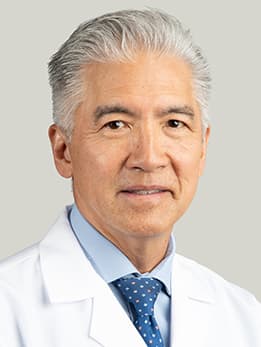Knee Pain: Causes, Diagnosis and Treatment
Expert Knee Care and Tailored Treatments

From nonsurgical treatment to minimally invasive robotic procedures and total knee replacement, orthopaedic specialists at the University of Chicago Medicine's Musculoskeletal Center can help you find the right treatment to move more freely and without pain.
As the largest joint in the body, the knee absorbs a tremendous amount of force with every step, making it susceptible to injury. Millions of people suffer severe knee pain in their bones, cartilage, ligaments and tendons.
Our orthopaedic specialists offer a full spectrum of care, including non-operative therapies, minimally invasive arthroscopy and joint replacement surgery to address the root cause of your knee pain and support long-term recovery.
You may find relief using nonsurgical treatment options. If these do not provide relief, your doctor might recommend a partial or total joint replacement. In joint-replacement surgery, also called arthroplasty, your surgeon replaces damaged bone and cartilage with an implant that will allow you to move your joint without pain.
At UChicago Medicine, we perform a high volume of joint-replacement surgeries every year. Higher surgery volumes are associated with better outcomes and lower rates of complications. Our orthopedic surgeons are at the forefront of joint-replacement surgery, including using robotic-arm-assisted technology. This technology helps to customize surgery to your unique needs.
Let's take a closer look at a total knee replacement. First, a CT scan of the knee generates a virtual 3D model of your unique joint. Your surgeon uploads this model into software to create your surgical plan. Your surgeon has the flexibility to modify this plan at any time based on your needs.
Your surgeon guides the robotic arm to remove the damaged bone and cartilage from the knee, keeping your healthy bone and cartilage in place. With the diseased bone gone, your surgeon inserts a knee implant into the joint space.
Robotic-assisted technology is just one example of how UChicago Medicine uses less-invasive surgery to help you recover faster. Our orthopedic program includes less-invasive surgery, specialized anesthetic techniques, and rapid-recovery physical therapy. Many of our patients are up and walking with more mobility and less pain within a day of surgery.
Ready to relieve your joint pain? UChicago Medicine is here to help.
Common Knee Pain Causes
Every year, people experience knee pain caused by sports injuries, arthritis, falls, vehicle collisions and more. UChicago Medicine orthopaedic and sports medicine specialists will help create a care plan to eliminate your knee pain and restore your mobility.
Common knee pain causes include:
ACL injuries are common among athletes and can cause instability, swelling and pain. The ACL stabilizes the knee joint when twisting or bending.
A torn meniscus (fibrocartilage shock absorber for the knee joint) that’s often caused by twisting or overuse of and can lead to pain, swelling and limited motion.
Pain in the front of the knee may stem from tracking issues involving the patella (kneecap) as it moves in a groove at the front of the femur (thigh bone). This may lead to cartilage damage over time.
Overstretching or tearing of ligaments and muscles around the knee can result in pain, stiffness or instability.
This overuse injury causes inflammation and pain where tendons attach to the bone. Patellar tendinitis may occur commonly in jumping athletes, but tendinitis can impact patients of all ages and activity levels.
Degenerative joint disease (osteoarthritis) in the knee is caused by the wear and tear of cartilage over time. This is the most common cause of knee pain in patients over the age of 40. Symptoms (pain, swelling and stiffness) may come and go, but gradually worsen over time.
Inflammation of the bursae, which are small fluid-filled sacs between the tendon and the bone. This can cause localized swelling and pain at the site of the bursa, often on the inside of the knee or directly over the kneecap. It’s often tender to the touch or when kneeling.
This overuse injury of the iliotibial (IT) band causes pain on the outside of the knee. It occurs when the thick band of tissue running from the hip to the outer knee is tight or inflamed.
This is a form of joint disease in adults caused by microscopic crystals forming within the joint fluid, which leads to pain, swelling and inflammation. Kidney disease and dietary factors may increase the risk for gout.
We also treat patients experiencing chronic knee pain or disability as a result of:
- Cancer
- Deformities
- Failed joint replacements
- Avascular necrosis or osteonecrosis
- Rheumatoid arthritis
- Traumatic injuries
Knee Pain Symptoms
Depending on the location and severity of your knee condition, you may experience one or more of the following symptoms:
- Swelling of the knee
- Knee stiffness or aching
- Weakness, instability or decreased flexibility of the knee
- Redness around the knee and warm to the touch
- A popping sound from the knee
- Limited motion, such as not being able to fully extend the knee
When to See a Doctor for a Knee Pain Diagnosis
We encourage patients to try self-care remedies — rest, ice, compression, elevation and over-the-counter anti-inflammatory medications — before seeking medical treatment for minor knee pain after an injury. If your pain persists or if the injury is severe, our knee specialists can evaluate the problem and offer the best treatment options for your condition.
Knee Pain Treatments
Not every knee injury or condition requires surgery. We prioritize conservative, evidence-based treatments to help you feel better and get moving, without the risks or downtime of surgery.
Many of our patients are up and walking within a day of surgery. Recovery time will depend on your procedure. We offer a multifaceted program for knee joint replacement (arthroplasty) that includes minimally invasive surgery, specialized anesthetic techniques, multi-modal pain management and rapid-recovery physical therapy for better knee surgery recovery time.
Comprehensive Knee Surgery Treatments
Our knee surgery team performs a wide range of treatments for knee pain. Based on your diagnosis and symptoms, we provide a customized treatment plan that will deliver the best outcomes and minimize your recovery time after knee surgery.
Treatments available for knee pain through UChicago Medicine:
This novel, minimally invasive procedure treats chronic knee pain caused by osteoarthritis or other degenerative conditions. The technique involves blocking blood flow to certain areas of the knee, which can help reduce joint inflammation, relieve pain and increase mobility. Learn more about GAE procedure.
Some patients with osteoarthritis require partial knee replacement for isolated disease in one area of the knee. This surgery resurfaces only the diseased portion of the cartilage and preserves healthy parts of the joint. Learn more about partial knee resurfacing.
If you experience severe arthritis or cartilage wear in more than one area of your knee, you may need total knee replacement surgery to restore your quality of life. In many cases, knee replacement can be performed with a minimally invasive approach, with robotic assistance or with smart implant technology. These techniques may allow for less pain, quicker recovery and better outcomes. Learn more about total knee replacement.
Knee arthroscopy is a surgical procedure using a tiny camera to examine and treat the inside of the knee. Your surgeon will make small incisions to insert the camera and small surgical tools for the procedure.
Arthroscopy may be recommended for the following knee problems:
- Torn meniscus
- Torn or damaged anterior cruciate ligament (ACL) or posterior cruciate ligament (PCL)
- Torn or damaged collateral ligament
- Kneecap (patella) that is out of position or misaligned
- Small pieces of broken cartilage in the knee joint
- Cartilage restoration
In select cases involving isolated areas of cartilage damage in the knee, restoring articular cartilage can be an effective way to improve pain and function. Our experts offer several innovative procedures designed to repair or regenerate small, localized areas of damaged cartilage.
One approach for treating surface-based cartilage defects involves harvesting healthy cartilage tissue from a non-weight-bearing area of the joint. These cells are then sent to a specialized laboratory, where they are cultured over 2–3 months to produce new cartilage cells. Using your own cells could help promote better integration with existing tissue and may lead to improved long-term outcomes.
Nonsurgical Knee Pain Treatment
Many knee injuries can be treated without surgery. Treatment options feature a combination of the following:
- Immobilization. Your doctor may recommend a brace to stabilize your knee. If you have a fractured bone, a cast or brace may hold the bones in place while they heal. You may need crutches to keep weight off your leg.
- Physical therapy. Specific exercises help restore your knee function and strengthen the leg muscles.
- Non-steroidal anti-inflammatory medicines (NSAIDs). Drugs like naproxen and ibuprofen reduce pain and swelling. Acetaminophen (Tylenol) is one of the safest options for most patients.
- Knee joint injections. Shots, including steroid or other types of medications, can be given to the knee to reduce pain and inflammation in the joint.
Whether your knee treatment includes a surgical procedure or less invasive options, orthopaedic specialists at UChicago Medicine can ensure you receive an accurate diagnosis and the most advanced knee pain treatment plan tailored to your needs.








